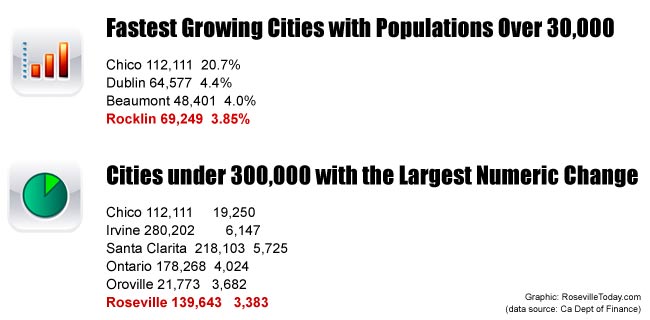Region’s success elicits mixed feelings from residents
Roseville, Calif.- One look around South Placer County and it’s easy to see why Roseville and Rocklin sit near the top of a recent California Department of Finance report on California population growth. For many reasons, it’s a fantastic place to live.
Ranking at the top of quality of life survey with an educated workforce and abundance of outdoor recreation opportunities, South Placer remains an attractive draw for those looking to escape higher priced and more dangerous California communities. (Placer County has the lowest violent crime rate in California.) For employers, average salaries in Placer County are below the California state average and are projected to remain below average for the foreseeable future.
Growth of this community and family-centric area shows no signs of abating anytime soon. Placer County is expected to add approximately 150,000 more residents in the next 20 years according the Placer County Planning Dept.

Growth at a Price
The success and growth of region always comes with a price that not all residents are excited about. Cookie cutter suburban sprawl, traffic bogs, some of the worst air quality in the nation along with changing demographics are just a few of the challenges facing the region. With the influx of new residents, this conservatively Republican stronghold in California is expected to eventually shift over to Democrats.
California Population Growth – Ca Dept of Finance
California added 186,807 residents to bring the state’s estimated total population to 39,927,315 people as of January 1st, 2019, according to new population estimates and housing data released by the California Department of Finance.
The report contains preliminary January 2019 and revised January 2018 population data for California cities, counties, and the state, and reflects the dramatic changes caused by the state’s catastrophic wildfires.
Key findings include:
The Camp Fire in Butte County was the most destructive wildfire in California history, with over 14,600 housing units destroyed. The fire destroyed almost 90 percent of the housing stock and displaced 83 percent of the population in the Town of Paradise, which suffered the loss of 11,371 housing units. The majority of the displaced persons relocated to the surrounding cities of Chico and Oroville, each adding more than 20 percent to their total populations.
With a population of 112,000, Chico saw the largest numeric change in the state, adding over 19,000 persons. With a population of 508,000 persons, Sacramento added over 7,400 persons. San Diego (1,421,000) added 6,200 persons, followed by Irvine (280,000) adding 6,100 persons. Santa Clarita (218,000) rounds out the top five cities by numeric growth with 5,700 new residents due to a large annexation from Los Angeles County.*
Throughout the state, more than 23,700 housing units were demolished in 2018, with wildfires heavily influencing a number of areas. The counties with most housing loss due to fire include Butte (14,600), Shasta (900), Ventura (700), and Lake (300). The City of Malibu in Los Angeles County also lost close to 500 housing units due to wildfire.*
In terms of population growth from housing production not related to wildfires, the top five cities include: Lathrop (5.2 percent) in San Joaquin County, San Juan Bautista (4.8 percent) in San Benito County, Dublin (4.4 percent) in Alameda County, Irwindale (4.1 percent) in Los Angeles County, and Beaumont (4.0 percent) in Riverside County.*
California’s statewide housing growth, as measured by net unit growth in completed housing units for 2018, was 77,000 units. Total housing in California reached 14,235,000 units, a 0.6- percent increase.
2018’s population growth rate of 0.47 percent is the slowest in the State’s history. This rate is driven by a significant decline in births, down by more than 18,000 over the previous year, as well and data reflecting lower student enrollment. Deaths continued an upward trend seen since 2010 as California’s “Baby Boomers” continue to age.
Ranked by net housing gains, Los Angeles (16,525), San Diego (4,505), Irvine (3,384), Santa Clarita (2,486) and Sacramento (2,353) added the most housing units in 2018.*
Of the ten largest cities in California, Sacramento had the largest percentage gain in population (1.49 percent, or 7,400) with Bakersfield (1.11 percent, or 4,300) a distant second.*
Of the 14,235,000 housing units in California, 9,186,000 are single family and 4,490,000 are multi-family with 560,000 mobile homes. Multi-family housing growth outpaced single family housing by over 1,900 net units (“net” refers to new construction minus demolition), narrowing the difference from previous years but continuing a seven-year trend. Los
Angeles led the state with 12,217 multi-family units, comprising 73.9 percent of their total housing growth, followed by San Diego (3,648 for 81.0 percent), San Francisco (2,277 for 99.5 percent), and Irvine (1,439 for 42.5 percent).*
State Prisons Impact
State prisons are generally located in remote areas; as a result, increases or decreases in this population can account for significant changes in their respective locations. For example, state prison declines led to population decreases in Calipatria in Imperial County, Chowchilla in Madera County, and Blythe and Norco in Riverside County, while driving population increases in Tehachapi in Kern County, Coalinga in Fresno County, Corcoran in Kings County, Folsom in Sacramento County, and Vacaville in Solano County.
Related population reports are available on the Department’s website.
(21+ years strong)
Welcome to the brighter side!
Get in front of local customers! 24/7 (365)





















